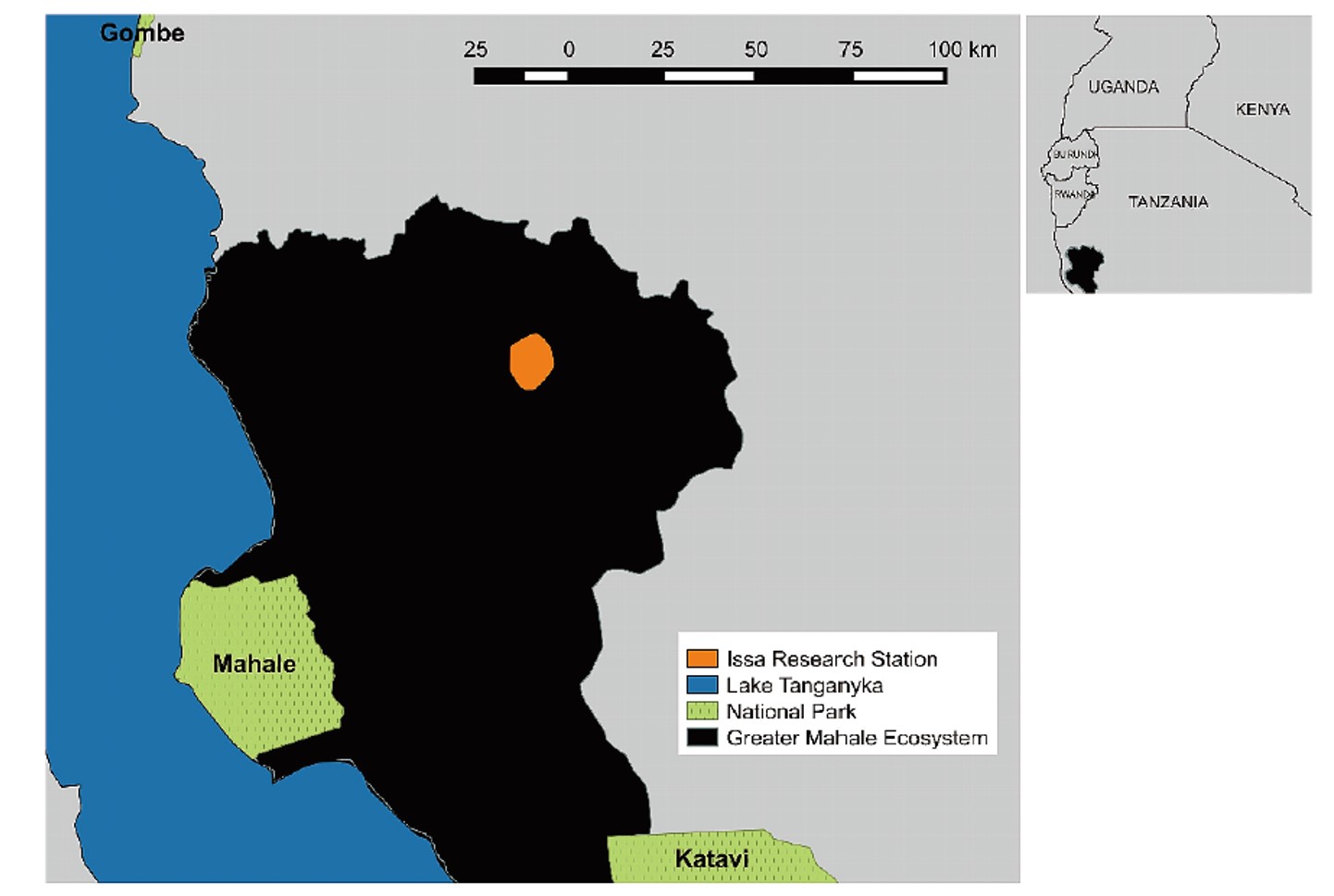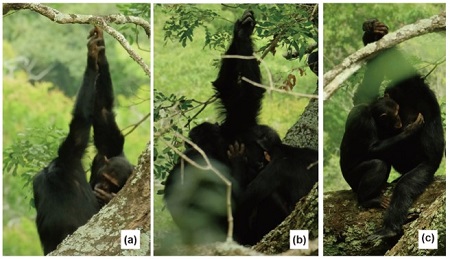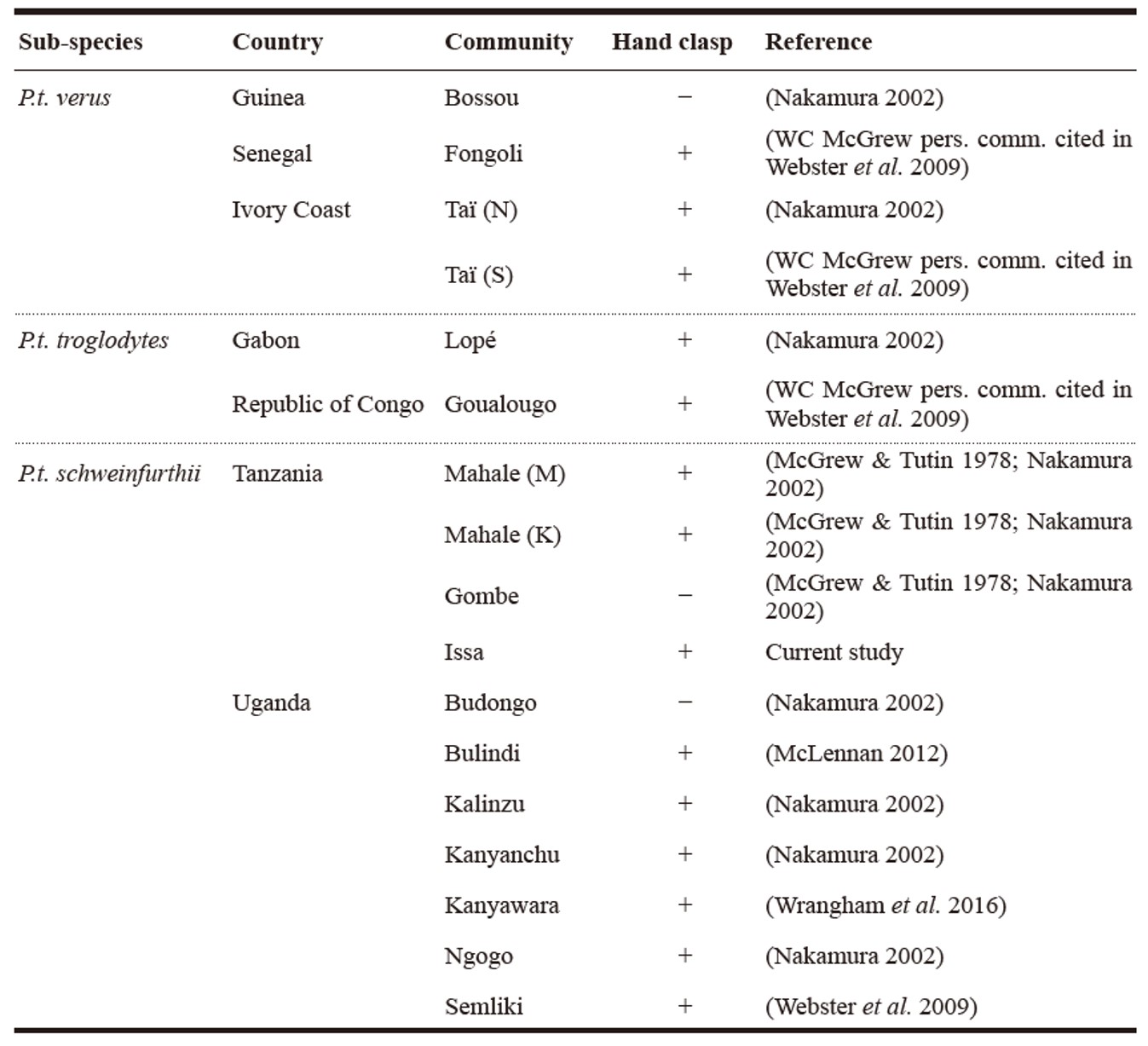|
<NOTE>
Grooming Hand Clasp by Chimpanzees (Pan troglodytes schweinfurthii) in the Issa Valley,Western Tanzania
Alex K. Piel1,2, Adrienne Chitayat1 & Fiona A. Stewart1,2
1 Ugalla Primate Project, Box 108, Uvinza, Kigoma, Tanzania 2 School of Natural Sciences and Psychology, Liverpool John Moores University, Liverpool, UK INTRODUCTION Despite over 300 years of combined study of wild chimpanzees, reports of social customs continue to emerge (e.g., social scratch, Nakamura et al. 2000), especially given an increased use of remote monitoring of behaviour of unhabituated communities, revealing behaviour like stone throwing that have never before been described (Kühl et al. 2016). However, it was the grooming hand clasp (GHC) that was first described as a social custom (McGrew & Tutin 1978), reported in chimpanzees from the Mahale Mountains National Park (MMNP) in Tanzania nearly a half century ago. The GHC results when two chimpanzees sitting and facing each other clasp their hands above their heads, arms at least partly extended and typically groom each other’s underarms. Subsequent reports have described variants of the behaviour (described also as “high arm grooming”—Wrangham et al. 2016) and its presence in other wild (Webster et al. 2009; McLennan 2012) and captive communities (de Waal & Seres 1997; Leeuwen et al. 2012) (see Table 1). Whiten et al. (2001) suggest that the behaviour may have originated from branch-clasp grooming (see more in McGrew, 2004) and have been subsequently lost in those chimpanzees where the behaviour has not been observed. One population where this may have occurred lives in Gombe National Park (GNP), about 200 km north of Mahale (Figure 1), where GHC has not been observed in six decades of close observation. Given the behavioural variability known to exist between even adjacent chimpanzee communities (Leeuwen et al. 2012; Luncz et al. 2012), the presence of GHC in Mahale, but its absence at Gombe is not surprising, but it does leave us wondering about social transmission of behaviour across western Tanzania. New records describing the GHC, especially in chimpanzees that live between the two parks, would further our understanding about the distribution of cultural traits in a fragmented landscape of chimpanzee presence. Here we report on the first observations of GHC in Issa Valley chimpanzees. METHODS The Issa Valley lies about 85 km east of MMNP and about 135 km southeast of GNP (Figure 1). The home range of the Issa community is over 85 km², and is comprised of a mosaic vegetation dominated by miombo woodland, interspersed with thin strips of gallery forest, seasonally inundated swamps, and rocky outcrops. As of April 2017, the Issa community was only partly habituated, with 14 chimpanzees individually recognisable to researchers. Initial genotyping results suggested a minimum community size of 67 (Rudicell et al. 2011). 
Figure 1. Map of western Tanzania, including the Issa Valley Research Station, Mahale Mountains and Gombe National Parks. OBSERVATION On 10 March 2017, researchers heard pant hoots early in the morning and followed the origins of the calling to a miombo woodland, not far from the research station. AP counted three individuals sitting in a Pterocarpus tinctorius tree: two were feeding on flowers and one adult female was resting. From further down the mountain pant hoots could be heard. AC then joined AP and together we followed the three individuals into a Brachystegia bussei tree, where another four individuals were resting arboreally, thereby comprising a total of seven individuals: two adult males, two sub-adult males, two adult females (one with a sexual swelling), and one infant. With the party comfortable with our presence, we slowly approached to within 20 m, from where we saw two males already engaged in a mutual grooming bout with arms extended and hands touching above them. Over the course of the subsequent 3-hr encounter, we observed the male dyad perform three different hand-clasp configurations (Figure 2a–c), as have been described in previous reports (Leeuwen et al. 2012). We did not time each configuration, but with a third individual present and occasionally entering the grooming bout, none of the configurations lasted more than a few minutes, with the entire grooming bout lasting about 20 min. 
Figure 2. Issa chimpanzees engaged in three types of grooming hand clasp. (a) wrist to palm, (b) palm to palm, and (c) wrist to wrist DISCUSSION We describe here the first observations of a wellknown chimpanzee social custom—the GHC—in a partially habituated community living in the Issa valley, Tanzania. These observations add to our understanding of the patterns of behavioural variation exhibited across the species. As Issa is nearly equidistant between the only two national parks with chimpanzees in Tanzania (GNP and MMNP), insight into the cultural behavioural repertoire at Issa raises the possibility of connectivity to these protected areas. Given the mosaic landscape and variable human population density across the region, it is currently unclear whether there exists chimpanzee population connectivity throughout the ecosystem; integrating sociallytransmitted behaviours may help us achieve this. GHC has now been observed at Mahale (Nakamura 2002) and Issa, less than 100 km to its east; it remains absent in Gombe. This continuity in social custom between the two more southern communities is consistent with current habitat connectivity, as there are both northern and southern corridors around a large human settlement situated between them (see more in Piel & Stewart, 2014). Our results also support genetic data that show greater similarity between Gombe and Uganda chimpanzees, than Gombe and Mahale (Langergraber et al. 2011), and overall, a genetic dissimilarity of Gombe chimpanzees compared to other Tanzanian populations (Inoue et al. 2011; Bonnin et al. 2015). However, the similarity in SIVcpz viral phylogeny that exists between Gombe and Issa, but not in the southern areas around Mahale (Rudicell et al. 2011), suggests either current or recent population connectivity between Issa and Gombe to the north (Piel et al. 2013). Accordingly, we would expect these two groups to share cultural behaviours; that they do not, and instead it is Issa and Mahale that share this social custom, supports connectivity between these southern communities. The incongruity between what the viral, genetic and cultural data tell us suggests that we simply do not have the complete picture of chimpanzee distribution and movement across the landscape. The variation in GHC presence in western Tanzania parallels what McLennan (2012) described for Uganda, with Bulindi, but not Sonso chimpanzees (25 km north) exhibiting the behaviour. He suggested that the absence of GHC in Sonso as well as Gombe and Bossou (see Table 1) reflects the GHC being a “dynamic social custom that… emerges and disappears in local populations repeatedly over time.” Whiten et al. (2001) have described “diffusion” as the most parsimonious explanation for the absence of any trait, whereby the trait is exhibited less and less over time, followed by its loss in the community of origin. They suggest that if a replacement alternative exists (at Gombe, for example, branch-clasp grooming), there may be no need to preserve the GHC at Gombe. Table 1. Study sites and communities where grooming hand clasp has been reported for wild chimpanzees (modified from Webster et al. 2009). + indicates the behaviour has been observed; - represents the absence of the behaviour to date. 
As we continue to learn about the Issa chimpanzee behavioural repertoire, we learn not only about overall chimpanzee behavioural variation, but also more specifically obtain critical data to better understand western Tanzanian chimpanzee population connectivity. ACKNOWLEDGMENTS The Tanzania Wildlife Research Institute (TAWIRI) and Commission for Science and Technology (COSTECH) provided permission for us to conduct research in Tanzania, and to the UCSD/Salk Center for Academic Research and Training in Anthropogeny (CARTA) for support to the Ugalla Primate Project. We thank WC McGrew for very helpful comments on an earlier version of this manuscript. REFERENCES Bonnin N, Piel AK, Ramirez M et al. 2015. Gene flow and genetic diversity of Tanzania’s Greater Mahale Ecosystem chimpanzees. Folia Primatol 86:249 (abstract). https://doi.org/10.1159/000435825 Inoue E, Tashiro Y, Ogawa H et al. 2011. Gene flow and genetic diversity of chimpanzees in Tanzanian habitats. Primate Conserv 26:1–8. Kühl HS, Kalan AK, Arandjelovic M et al. 2016. Chimpanzee accumulative stone throwing. Sci Rep 6:1–8. https://doi.org/10.1038/srep22219 Langergraber KE, Boesch C, Inoue E et al. 2011. Genetic and “cultural” similarity in wild chimpanzees. Proc Biol Sci 278:408–416. https://doi.org/10.1098/rspb.2010.1112 Leeuwen EJC Van, Cronin KA, Haun DBM, Mundry R, Bodamer MD 2012. Neighbouring chimpanzee communities show different preferences in social grooming behaviour. Proc R Soc B rspb20121543. https://doi.org/10.1098/rspb.2012.1543 Luncz LV, Mundry R, Boesch C 2012. Evidence for cultural differences between neighboring chimpanzee communities. Curr Biol 22:922–926. https://doi.org/10.1016/j.cub.2012.03.031 McGrew WC 2004. The Cultured Chimpanzee. Cambridge University Press, Cambridge. McGrew WC, Tutin CEG 1978. Evidence for a social custom in wild chimpanzees. Man 13:234–251. https://doi.org/10.2307/2800247 McLennan MR 2012. Preliminary observations of hand-clasp grooming by chimpanzees at Bulindi, Uganda. Pan Afr News 18:18–20. Nakamura M 2002. Grooming hand-clasp in Mahale M group chimpanzees: implications for culture in social behaviours. In: Behavioural Diversity in Chimpanzees and Bonobos. Boesch C, Hohmann G, Marchant LF (eds), Cambridge University Press, Cambridge, pp.71–83. Nakamura M, McGrew WC, Marchant LF, Nishida T 2000. Social scratch: Another custom in wild chimpanzees? Primates 41:237–248. https://doi.org/10.1007/BF02557594 Piel AK, Stewart FA 2014. Census and conservation status of chimpanzees (Pan troglodytes schweinfurthii) across the Greater Mahale Ecosystem. Report submitted to the The Nature Conservancy, USA. Piel AK, Stewart FA, Pintea L et al. 2013. The Malagarasi River does not form an absolute barrier to chimpanzee movement in Western Tanzania. PLoS One 8:e58965. https://doi.org/10.1371/journal.pone.0058965 Rudicell RS, Piel AK, Stewart F et al. 2011. High prevalence of simian immunodeficiency virus infection in a community of savanna chimpanzees. J Virol 85:9918–9928. https://doi.org/10.1128/JVI.05475-11 de Waal FBM, Seres M 1997. Propagation of handclasp grooming among captive chimpanzees. Am J Primatol 43:339–346. https://doi.org/10.1002/(SICI)1098-2345(1997)43:4<339::AID-AJP5>3.0.CO;2-Y Webster TH, Phineas R, Hunt KD 2009. Grooming handclasp by chimpanzees of the Mugiri community, Toro-Semliki Wildlife Reserve, Uganda. Pan Afr News 16:5–7. Whiten A, Goodall J, McGrew WC et al. 2001. Charting cultural variation in chimpanzees. Behaviour 138:1481–1516. https://doi.org/10.1163/156853901317367717 Wrangham RW, Koops K, Machanda ZP et al. 2016. Distribution of a chimpanzee social custom is explained by matrilineal relationship rather than conformity. Curr Biol 26:3033–3037. https://doi.org/10.1016/j.cub.2016.09.005 Back to Contents |